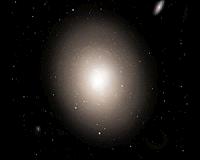 |
San Diego CA (SPX) Dec 06, 2010 Astronomers have traced the waxing and waning light of exploding stars more closely than ever before and seen patterns that aren't yet accounted for in our current understanding of how these eruptions occur. Using data from a sensitive instrument aboard a satellite that images the entire sky every 102 minutes, they studied four of these stars, or novae, that exploded so violently their light would have been visible without a telescope and measured their brightness over the course of the outburst. Three of the novae stalled before reaching a peak, and all flickered or flared as the explosions ran their course, they report in The Astrophysical Journal. The instrument they used - the Solar Mass Ejection Imager - was developed by a team led by astrophysicist Bernard Jackson at the Center for Astrophysics and Space Sciences at the University of California, San Diego, to study the sun. Rebekah Hounsell, a graduate student at Liverpool John Moores University in Britain made the measurements while visiting UC San Diego. Because starlight is a distraction for Jackson's team, noise they must subtract from their data so that they can focus on the sun's outer corona and the heliosphere, they make detailed maps of stellar light, including its brightness. In those maps Hounsell identified the four novae by finding points of light that rapidly brightened and dimmed over the course of days.
Wavering Light "The reality of this halt as found in all three of the fast-declining novae observed is a challenge to detailed models of the nova outburst," said one of the authors, astrophysicist Mike Bode, of Liverpool John Moores University. Two independent teams of theorists have already begun to refine their models of how novae explode in response. Astronomers typically characterize novae's changing light with curves smoothly fit to more sporadic observations, but the rapid cadence of the solar imager captured glimmers that hadn't been observed before. All flickered as their light dimmed and one nova, the slowest of the four to dim, flared brightly twice after reaching its peak luminosity. These novae are white dwarf stars that steal matter, in the form of hydrogen, from a companion star, often an aging, expanding red giant. As hydrogen accumulates the white dwarf's gravity pulls it in and condenses it until it ignites, setting off a runaway nuclear fusion reaction. The team speculates that the post-peak flares may correspond to changes in the dynamics of that reaction that still need to be explained.
Catching Missing Stars Data from the imager, which has been in operation aboard the Coriolis satellite since January 2003, allows astronomers to measure novae that they initially missed. "Even today novae are mainly discovered by amateur astronomers around the world who then alert their professional counterparts to conduct observations," Hounsell said. As many as five novae bright enough to be detected by SMEI explode in our galaxy each year, Allen Shafter, astronomy professor at San Diego State University and one of the co-authors of the report have previously estimated, but more than half have gone undetected. "The instrument assures that the brightest and most rapidly evolving novae - ones that brighten and then fade within a few days - are not overlooked," Shafter said. "The high time resolution of these observations has opened up a new window into the study of novae in our galaxy."
Share This Article With Planet Earth
Related Links University of California - San Diego Stellar Chemistry, The Universe And All Within It
 The Universe Does Think Small
The Universe Does Think SmallBoston MA (SPX) Dec 03, 2010 The biggest galaxies in the universe are elliptical galaxies. The largest of these hold over one trillion stars according to astronomical census takers, compared to 400 billion in our Milky Way. However, new research shows that elliptical galaxies actually hold five to ten times as many stars as previously believed. This means that the total number of stars in the universe is likely three ... read more |
|
| The content herein, unless otherwise known to be public domain, are Copyright 1995-2010 - SpaceDaily. AFP and UPI Wire Stories are copyright Agence France-Presse and United Press International. ESA Portal Reports are copyright European Space Agency. All NASA sourced material is public domain. Additional copyrights may apply in whole or part to other bona fide parties. Advertising does not imply endorsement,agreement or approval of any opinions, statements or information provided by SpaceDaily on any Web page published or hosted by SpaceDaily. Privacy Statement |